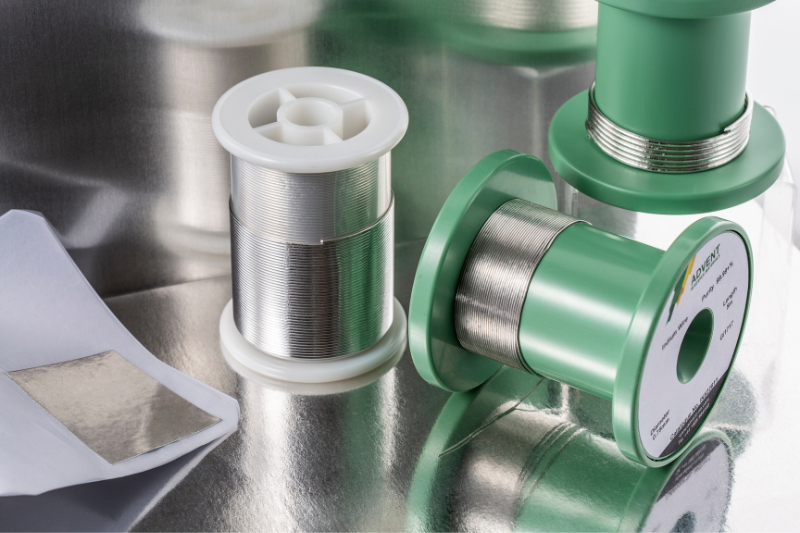Indium
Advent Research Materials Ltd supplies Indium (In) in the form of foil, wire and ingots in various sizes and quantities.
Few people outside the world of chemistry know about the element indium; yet it is found playing a very important role in several commonly used products.
Indium is a soft, silver-white post-transitional metal, meaning its melting point of 156.6 degrees Celsius and boiling point of 2072 degrees Celsius are both lower than those of transitional metals. Due to this distance between melting and boiling points with indium, the element has an extraordinary large working liquid range.
Indium is also part of the alloy, galinstan, which is a non-toxic liquid at room temperature. This alloy is a combination gallium, indium and tin.
There are several uses for indium that take advantage of its soft, malleable and ductile properties. The element is so soft (Mohs hardness 1.2) that it leaves a mark when drawn across a piece of paper, and can be cut into with a knife at room temperature. Due to its softness, it can be manipulated and easily drawn out into wire. One of the most common uses of indium wire is in high vacuum seals. As a wire, indium is also used as a thermal conductor in cryogenics and other ultra-high vacuums.
Indium’s low melting point lends it to being alloyed easily in solders. Another popular use for indium is in its foil form. Thin indium foil can be used as a conductive coating that is heated to fit between a heat-transfer surface of a microprocessor and heat sink.
Indium is also used in soldering, in order to provide a stress-free bond between a ceramic sputter target and a target holder. This bond is also electrical and thermal conducting.
Indium is used for medical purposes as it emits a small amount of gamma radiation, which enables it to be used as a tracer throughout the body.
Although indium does not react with water, it can still be oxidized by other, stronger oxidizing agents like halogens, producing the indium(III) compounds like indium(III) oxide.
One of the most common uses for indium that appear in several commercial products is in the semiconductors and thin films used in the making of liquid crystal displays (LCDs).
.png?width=50)
Indium Foil
| Line Number & Material | Thickness | Purity | Description | |
|---|---|---|---|---|
| IN1593 Indium Foil | 0.050 mm | 99.999% | High Purity. | View item |
| IN1606 Indium Foil | 0.08 mm | 99.999% | High Purity. | View item |
| IN1602 Indium Foil | 0.10 mm | 99.99% | - | View item |
| IN1592 Indium Foil | 0.1 mm | 99.999% | High Purity. | View item |
| IN1600 Indium Foil | 0.125 mm | 99.99% | - | View item |
| IN1594 Indium Foil | 0.125 mm | 99.999% | High Purity. | View item |
| IN1603 Indium Foil | 0.2 mm | 99.99% | - | View item |
| IN1604 Indium Foil | 0.2 mm | 99.999% | High Purity. | View item |
| IN1598 Indium Foil | 0.25 mm | 99.99+% | - | View item |
| IN1605 Indium Foil | 0.25 mm | 99.9987+% | High Purity. Coil width 25mm. | View item |
| IN1595 Indium Foil | 0.25 mm | 99.999% | High Purity. | View item |
| IN1601 Indium Foil | 0.5 mm | 99.99% | - | View item |
| IN1596 Indium Foil | 0.5 mm | 99.999% | High Purity. | View item |
| IN1599 Indium Foil | 1.0 mm | 99.99+% | - | View item |
| IN1597 Indium Foil | 1.0 mm | 99.999% | High Purity. | View item |
| IN1607 Indium Foil | 2.0 mm | 99.99+% | - | View item |
| IN1608 Indium Foil | 2.0 mm | 99.999% | High Purity. | View item |
Indium Wire
| Line Number & Material | Diameter | Purity | Description | |
|---|---|---|---|---|
| IN5220 Indium Wire | 0.25 mm | 99.999% | High Purity. | View item |
| IN5221 Indium Wire | 0.5 mm | 99.999% | High Purity. | View item |
| IN5227 Indium Wire | 0.6 mm | 99.99+% | - | View item |
| IN5228 Indium Wire | 0.75 mm | 99.99+% | - | View item |
| IN5223 Indium Wire | 1 mm | 99.99+% | - | View item |
| IN5222 Indium Wire | 1 mm | 99.999% | High Purity. | View item |
| IN5225 Indium Wire | 1.6 mm | 99.99+% | - | View item |
| IN5226 Indium Wire | 2 mm | 99.99+% | - | View item |
| IN5229 Indium Wire | 2.5 mm | 99.999% | High Purity. | View item |
| IN5224 Indium Wire | 4 mm | 99.99+% | - | View item |
Indium Ingots
| Line Number & Material | Purity | Description | |
|---|---|---|---|
| IN9008 Indium Ingots | 99.99% | - | View item |
| IN9010 Indium Ingots | 99.999% | High Purity. | View item |